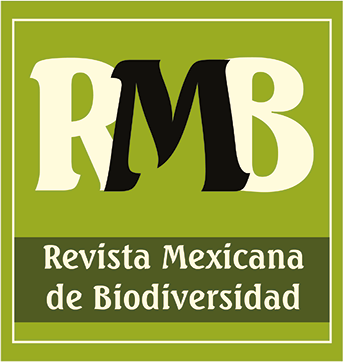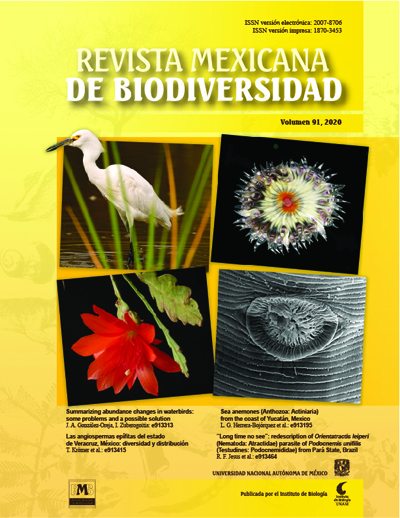Ecology of the neotropical otter (Lontra longicaudis) in southern Tehuacán-Cuicatlán Biosphere Reserve, Mexico
DOI:
https://doi.org/10.22201/ib.20078706e.2020.91.2820Palabras clave:
Density, Feeding habits, Geographic distribution, Habitat, Mustelidae, Protected areasResumen
Land otters are predators at the top of the food chain in the rivers where they live and mold the biotic communities at lower trophic levels. The neotropical otter, Lontra longicaudis, is widely distributed in the Americas, but populations are being decimated by hunting, habitat loss, water pollution, and roadkills. An otter population was located in southern Tehuacán-Cuicatlán Biosphere Reserve (TCBR), Mexico. Surveys were conducted in the dry season to determine otter
presence, to record physical-chemical data and to collect scats to determine their populational densities and feeding habits. River width and depth, dissolved oxygen and elevation were the significant variables that explained their presence. In the rivers where otters were present, we estimated densities between 0.19 and 0.22 otters/km. We found 12 prey taxa, mainly freshwater fish. In this protected area, the neotropical otter is restricted to large rivers at low elevations, and populations are low. Although otters have diverse feeding habits, they mainly prey upon Poeciliopsis spp., which constituted 60% of the scats. Density estimates comprise the dry season and were lower than previous surveys, therefore it is necessary to conduct yearly monitoring to identify trends and to implement actions focused on their conservation and management.
Citas
Alarcon, G. G., & Simões-Lopes, P. C. (2003). Preserved versus degraded coastal environments: a case study of the Neotropical otter in the environmental protection area of Anhatomirim, Southern Brazil. IUCN Otter Specialist Group Bulletin, 20, 6–18.
Anzueto, M. J., Velázquez, E., Gómez, A. E., Quiñonez, R. M., & Joyce, B. (2013). Peces de la Reserva de la Biosfera Selva El Ocote, Chiapas, México. Informe técnico. Tuxtla Gutiérrez: Universidad de Ciencias y Artes de Chiapas.
Aranda, M. (2000). Huellas y otros rastros de los mamíferos grandes y medianos de México. Xalapa: Instituto de Ecología, A.C.
Arellano, N., Sánchez, E., & Mosqueda, M. A. (2012). Distribución y abundancia de la nutria neotropical (Lontra longicaudis annectens) en Tlacotalpan, Veracruz. Acta Zoológica Mexicana (n.s.), 8, 270–279. https://doi.org/10.21829/azm.2012.282832
Arriaga, L., Espinoza, J. M., Aguilar, C., Martínez, E., Gómez, L., & Loa, E. (Coord.). (2000). Regiones terrestres prioritarias de México. Ciudad de México: Comisión Nacional para el Conocimiento y uso de la Biodiversidad.
Bockmann, F. A., & Guazzelli, G. M. (2003). Heptapteridae (Heptapterids). In R. E. Reis, S. O. Kullander, & C. J. Ferraris, Jr. (Eds.), Checklist of the freshwater fishes of South and Central America (pp. 406–431). Porto Alegre: EDIPUC.
Botello, F., Salazar, J. M., Illoldi, P., Linaje, M., Monroy, G., Duque, D. et al. (2006). Primer registro de la nutria neotropical de río (Lontra longicaudis) en la Reserva de la Biosfera de Tehuacán-Cuicatlán, Oaxaca, México. Revista Mexicana de Biodiversidad, 77, 133-135. http://doi.org/10.22201/ib.20078706e.2006.001.323
Briones-Salas, M., Cruz, J., Gallo-Reynoso, J. P., & Sánchez-Cordero, V. (2008). Abundancia de la nutria neotropical de río (Lontra longicaudis annectens Major, 1897) en el río Zimatán en la costa de Oaxaca, México. In C. Lorenzo, E. Medinilla, & J. Ortega (Eds.), Avances en el estudio de los mamíferos de México II (pp. 354–376). Ciudad de México: Asociación Mexicana de Mastozoología, A.C. (AMMAC).
Briones-Salas, M., Peralta-Pérez, M. A., & Arellanes, E. (2013). Análisis temporal de los hábitos alimentarios de la nutria neotropical (Lontra longicaudis) en el río Zimatán en la costa de Oaxaca, México. Theyra, 4, 311–326. https://doi.org/10.12933/therya-13-138
Carrillo-Rubio, E., & Lafón, A. (2004). Neotropical river otter micro-habitat preference in west-central Chihuahua, Mexico. IUCN Otter Specialist Group Bulletin, 21, 10–15.
Casariego-Madorell, M., List, R., & Ceballos, G. (2006). Aspectos básicos sobre la ecología de la nutria de río (Lontra longicaudis annectes) para la costa de Oaxaca. Revista Mexicana de Mastozoología, 10, 71–74. https://doi.org/10.22201/ie.20074484e.2006.10.1.143
Conkel, D. (1993). Cichlids of North and Central America. New Jersey: T.F.H. Publications.
de Almeida, L. R., & Ramos, M. J. (2017). Ecology and biogeography of the Neotropical otter Lontra longicaudis: existing knowledge and open questions. Mammal Research, 62, 313–321. https://doi.org/10.1007/s13364-017-0333-1
Duque-Dávila, D., Martínez-Ramírez, E., Botello, F. J., & Sánchez-Cordero, V. (2013). Distribución, abundancia y hábitos alimentarios de la nutria (Lontra longicaudis annectens Major, 1897) en el río Grande, Reserva de la Biosfera Tehuacán-Cuicatlán, Oaxaca, México. Therya, 4, 281–296. https://doi.org/10.12933/therya-13-128
Eberhardt, L., & Van Etten, R. C. (1956). Evaluation of the pellet group count as a deeer census method. The Journal of Wildlife Management, 20, 70–74. https://doi.org/10.2307/3797250
Feisinger, P., Spears, E., & Poole, R. (1981). A simple measure of niche breath. Ecology, 62, 27–32. https://doi.org/10.2307/1936664
Gallo-Reynoso, J. P. (1996). Distribution of the neotropical river otter (Lontra longicaudis annectens Major, 1897) in the río Yaqui, Sonora. IUCN Otter Group Specialist Bulletin, 13, 27–31.
Gallo-Reynoso, J. P., Ramos-Rosas, N. N., & Rangel-Aguilar, O. (2008). Depredación de aves acuáticas por la nutria neotropical (Lontra longicaudis annectens), en el río Yaqui, Sonora, México. Revista Mexicana de Biodiversidad, 79, 275–279. http://dx.doi.org/10.22201/ib.20078706e.2008.001.502
Gomez, J. J., Túnez, J. I., Fracassi, N., & Cassini, M. H. (2014). Habitat suitability and anthropogenic correlates of Neotropical river otter (Lontra longicaudis) distribution. Journal of Mammalogy, 95, 824–833. https://doi.org/10.1644/
-MAMM-A-265
González, A. A. (2008). Estudio morfométrico y osteológico del género Profundulus (Cyprinodontiformes: Profundulidae) (Masters thesis). Querétaro: Universidad Autónoma de Querétaro.
González-Christen, A., Delfín-Alonso, C. A., & Sosa-Martínez, A. (2013). Distribución y abundancia de la nutria neotropical (Lontra longicaudis annectens Major, 1897), en el Lago de Catemaco, Veracruz, México. Therya, 4, 201–217. https://doi.org/10.12933/therya-13-125
Guerrero-Flores, J. J., Macías-Sánchez, S., Mundo, V., & Méndez-Sánchez, F. (2013). Ecología de la nutria (Lontra longicaudis) en el municipio de Temascaltepec, estado de México: estudio de caso. Therya, 4, 231–242. https://doi.org/10.12933/therya-13-127
Huber, J. H. (1996). Killi-Data 1996. Updated checklist of taxonomic names, collecting localities and bibliographic references of oviparous Cyprinodont fishes (Atherinomorpha, Pisces). Paris: Société Française d'Ichtyologie, Muséum National d'Histoire Naturelle.
Huidobro-Campos, L. (2000). Peces. In G. De la Lanza, S. Espino, & J. L. Carbajal (Eds.), Organismos indicadores de la calidad del agua y de contaminación (bioindicadoras) (pp. 195–263). Ciudad de México: Secretaría de Medio Ambiente Recursos Naturales y Pesca/ Comisión Nacional del Agua/ Universidad Nacional Autónoma de México/ Plaza Valdés y Editores.
INEGI (Instituto Nacional de Estadística, Geografía e Informática). (2010). National census 2010 [Access in 2016]. Available at: https://www.inegi.org.mx/programas/ccpv/2010/
INEGI (Instituto Nacional de Estadística, Geografía e Informática). (2013). Land cover and use of Mexico, scale 1:25000 [Access in 2016]. Available at: https://www.inegi.org.mx/temas/usosuelo/
IUCN (International Union for Conservation of Nature). (2016). Red List of Threatened Species, IUCN-SSC [Access in 2016]. Available at: www.redlist.org
Krebs, C. J. (1989). Ecological methodology. New York: Harper Collins.
Kruuk, H. (2006). Otters: ecology, behavior and conservation. Oxford: Oxford University Press.
Lavière, S. (1999). Lontra longicaudis. Mammalian Species, 609, 1–5.
Lucinda, P. H. F. (2003). Poeciliidae (Livebearers). In R. E. Reis, S. O. Kullander, & C. J. Ferraris, Jr. (Eds.), Checklist of the freshwater fishes of South and Central America (pp. 555–581). Porto Alegre, Brazil: EDIPUCRS.
Macías-Sánchez, S., & Aranda, M. (1999). Análisis de la alimentación de la nutria Lontra longicaudis (Mammalia: Carnivora) en un sector del río Los Pescados, Veracruz, México. Acta Zoológica Mexicana (n.s.), 76, 49–57.
Martínez-Ramírez, E. (2017). Proyecto LI007 Diagnóstico de las especies invasoras de peces en el área oaxaqueña de la Reserva de la Biosfera Tehuacán-Cuicatlán. Informe técnico. Ciudad de México: Comisión Nacional para el Conocimiento y uso de la Biodiversidad.
Martínez-Ramírez, E., Cruz Arenas, E., Cruz-Ruíz, G. I., & Gómez-Ugalde, R. M. (2013). Los peces de la Reserva de la Biosfera Tehuacán-Cuicatlán, Región Oaxaca. In M. Briones-Salas, G. Manzanero-Medina, & G. González-Pérez (Eds.), Estudios en zonas áridas de Oaxaca. Homenaje al Dr. Alejandro Flores Martínez (pp. 130–144). Ciudad de Oaxaca: CIIDIR-IPN Unidad Oaxaca.
Miller, R. R., Minckley, W. L., & Norris, S. M. (2009). Peces dulceacuícolas de México. México D.F.: Comisión Nacional para el Conocimiento y Uso de la Biodiversidad/ Sociedad Ictiológica Mexicana, A.C./ El Colegio de la Frontera Sur/ Consejo de los Peces del Desierto México-Estados Unidos.
Monroy-Vilchis, O., & Mundo, V. (2009). Nicho trófico de la nutria neotropical (Lontra longicaudis) en un ambiente modificado, Temascaltepec, México. Revista Mexicana de Biodiversidad, 80, 801–808. https://doi.org/10.1016/j.rmb.2017.07.001
Muãnis, M. C., & Oliveira, L. F. B. (2011). Habitat use and food niche overlap by Neotropical otter, Lontra longicaudis, and giant otter, Pteronura brasiliensis, in the Pantanal wetland, Brazil. Otter Specialist Group Bulletin, 28, 76–85.
Palma, A. (2013). Guía para la identificación de macroinvertebrados acuáticos. Santiago, Chile: Departamento de Ecología y Medio Ambiente, Instituto de Filosofía y Ciencias de la Complejidad.
R Core Team. (2013). R: a language and environment for statistical computing. R foundation for statistical computing, Vienna, Austria [Access in 2016]. Available in: http://www.R-project.org/
Rheingantz, M. L., Oliveira-Santos, L. G. R., Waldemarin, H. F., & Pellegrini, E. (2012). Are otters generalists or do they prefer larger, slower prey? Feeding flexibility of the Neotropical Otter Lontra longicaudis in the Atlantic Forest. IUCN Otter Specialist Group Bulletin, 29, 80–94.
Rheingantz, M. L., Santiago-Plata, V. M., & Trinca, C. S. (2017). The Neotropical otter Lontra longicaudis: a comprehensive update on the current knowledge and conservation status of this semiaquatic carnivore. Mammal Review, 47, 291–305. https://doi.org/10.1111/mam.12098
Rheingantz, M. L., & Trincam, C. S. (2015). Lontra longicaudis. The IUCN Red List of Threatened Species 2015: e.T12304A21937379. [Access in 2015]. Available at: http://dx.doi.org/10.2305/IUCN.UK.2015-2.RLTS.T12304
A21937379.en
Ruiz-Velásquez, E., Andrés-Reyes, J. V., & Santos-Moreno, A. (2014). Registros notables de tres especies de mamíferos del estado de Oaxaca, México. Revista Mexicana de Biodiversidad, 85, 325–327. https://doi.org/10.7550/rmb.33961
Santiago-Plata, V. M., Valdez-Leal, J. D., Pacheco-Figueroa, C. J., Cruz-Burelo, F., & Moguel-Ordóñez, E. J. (2013). Aspectos ecológicos de la nutria neotropical (Lontra longicaudis annectens) en el camino La Veleta en la Laguna de Términos, Campeche, México. Therya, 2, 265–280. https://doi.org/10.12933/therya-13-131
Trejo, I. (2004). Clima. In A. J. García-Mendoza, J. M. Ordóñez, & M. Briones-Salas (Eds), Biodiversidad de Oaxaca (pp. 67–85). Ciudad de México: Instituto de Biología, UNAM/ Fondo Oaxaqueño para la Conservación de la Naturaleza/ World Wildlife Fund.
Velázquez-Velázquez, E., Gómez-González, A. E., Vega-Cendejas, M. E., Rivera-Velázquez, G., & Domínguez-Cisneros, S. E. (2007). Peces del sistema estuarino Carretas-Pereyra, Reserva de la Biosfera La Encrucijada, Chiapas. Lacandonia, 1, 45–54.
Velázquez-Velázquez, E., Maza-Cruz, M., Gómez-González, A. E., & Navarro-Alberto, J. A. (2015). Length-weight relationships for 32 fish species in the Grijalva River Basin, Mexico. Journal of Applied Ichthyology, 31, 413–414. https://doi.org/10.1111/jai.12676
Zuur, F., Ieno, E. N., Walker, N. J., Saveliev, A. A., & Smith, G. M. (2009). Mixed effects models and extensions in ecology with R. New York: Springer.




